PRODUCT Properties
| Melting point: | 163-164 °C |
| Boiling point: | 402.6°C (rough estimate) |
| Density | 1.0280 (rough estimate) |
| refractive index | 1.5500 (estimate) |
| storage temp. | -20°C Freezer, Under inert atmosphere |
| solubility | DMSO (Slightly), Methanol (Slightly) |
| pka | 13.84±0.20(Predicted) |
| form | Solid |
| color | White to Off-White |
| Water Solubility | 80.99mg/L(25 ºC) |
| InChI | InChI=1S/C16H21NO2/c1-12(2)17-10-14(18)11-19-16-9-5-7-13-6-3-4-8-15(13)16/h3-9,12,14,17-18H,10-11H2,1-2H3 |
| InChIKey | AQHHHDLHHXJYJD-UHFFFAOYSA-N |
| SMILES | C(NC(C)C)C(O)COC1=C2C(C=CC=C2)=CC=C1 |
| CAS DataBase Reference | 525-66-6 |
| NIST Chemistry Reference | Propranolol(525-66-6) |
| EPA Substance Registry System | 2-Propanol, 1-[(1-methylethyl)amino]-3-(1-naphthalenyloxy)- (525-66-6) |
Description and Uses
Propranolol was responsible for sensitisation of workers in drug synthesis. In one case, epichlorhydrin was used for the production of both propranolol and oxprenolol.
Cardiac depressant (anti-arrhythmic); anti-adrenergic (β-receptor).





